Contemporary Issues in Business: Analyzing Cybersecurity in Banks
VerifiedAdded on 2023/06/11
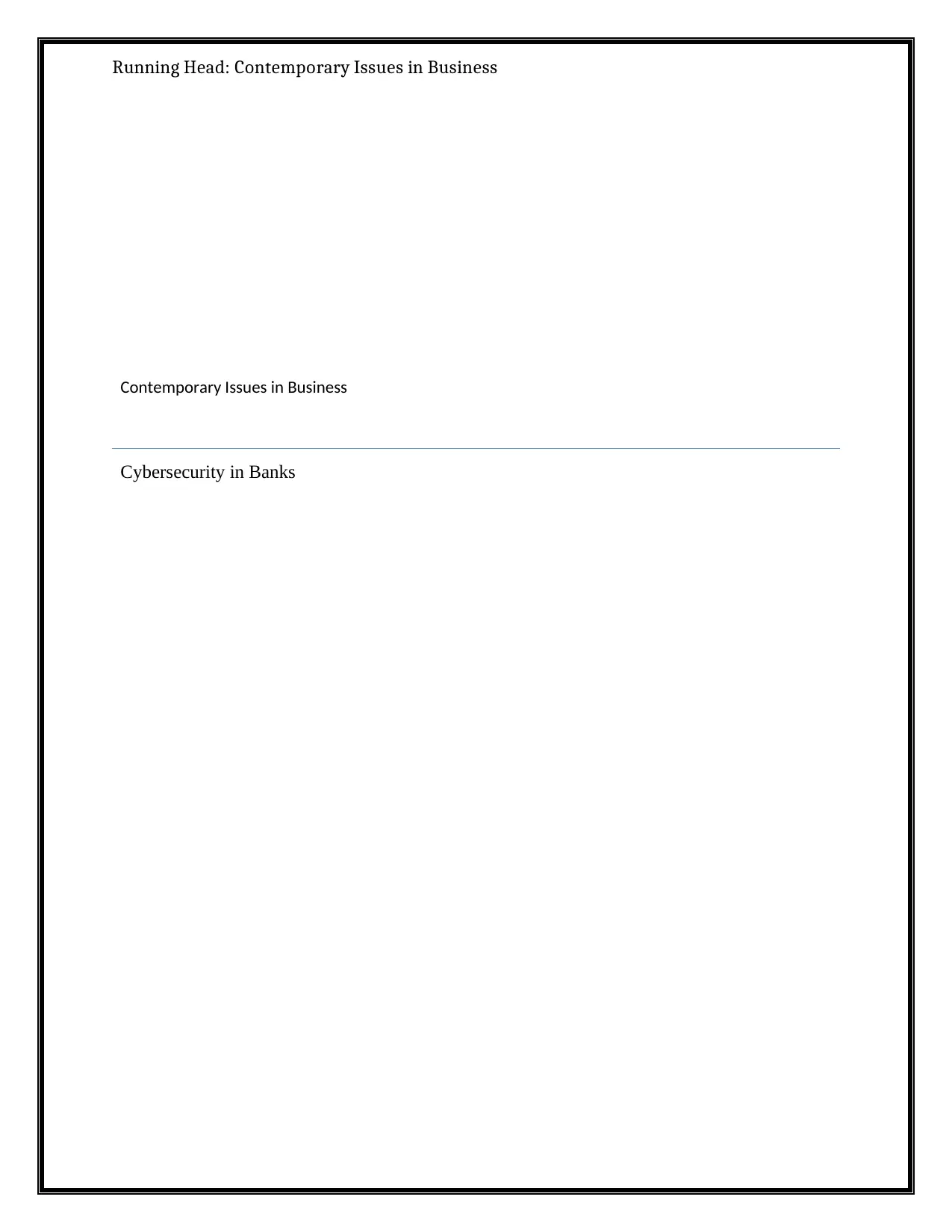
Contemporary Issues in Business
Cybersecurity in Banks
Paraphrase This Document
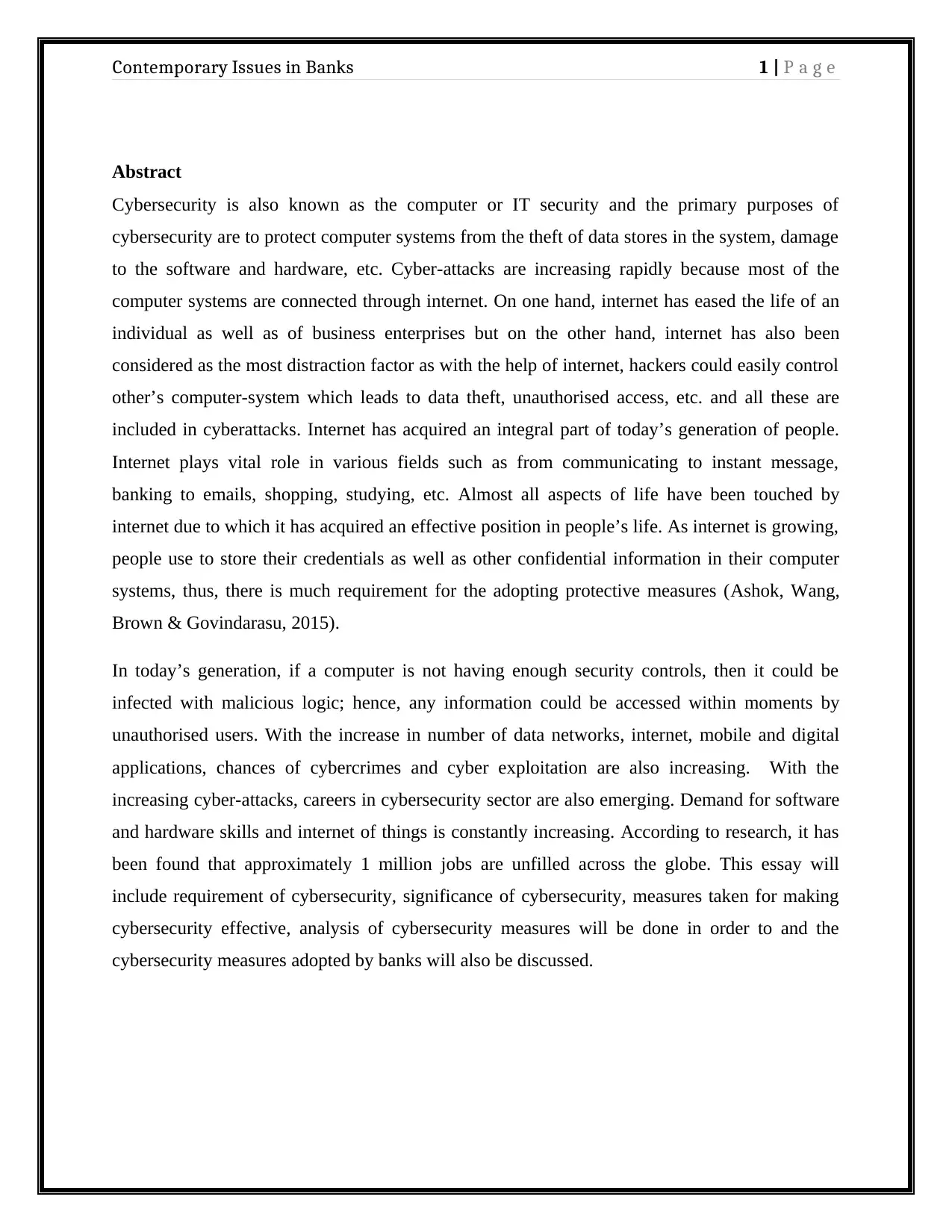
Abstract
Cybersecurity is also known as the computer or IT security and the primary purposes of
cybersecurity are to protect computer systems from the theft of data stores in the system, damage
to the software and hardware, etc. Cyber-attacks are increasing rapidly because most of the
computer systems are connected through internet. On one hand, internet has eased the life of an
individual as well as of business enterprises but on the other hand, internet has also been
considered as the most distraction factor as with the help of internet, hackers could easily control
other’s computer-system which leads to data theft, unauthorised access, etc. and all these are
included in cyberattacks. Internet has acquired an integral part of today’s generation of people.
Internet plays vital role in various fields such as from communicating to instant message,
banking to emails, shopping, studying, etc. Almost all aspects of life have been touched by
internet due to which it has acquired an effective position in people’s life. As internet is growing,
people use to store their credentials as well as other confidential information in their computer
systems, thus, there is much requirement for the adopting protective measures (Ashok, Wang,
Brown & Govindarasu, 2015).
In today’s generation, if a computer is not having enough security controls, then it could be
infected with malicious logic; hence, any information could be accessed within moments by
unauthorised users. With the increase in number of data networks, internet, mobile and digital
applications, chances of cybercrimes and cyber exploitation are also increasing. With the
increasing cyber-attacks, careers in cybersecurity sector are also emerging. Demand for software
and hardware skills and internet of things is constantly increasing. According to research, it has
been found that approximately 1 million jobs are unfilled across the globe. This essay will
include requirement of cybersecurity, significance of cybersecurity, measures taken for making
cybersecurity effective, analysis of cybersecurity measures will be done in order to and the
cybersecurity measures adopted by banks will also be discussed.
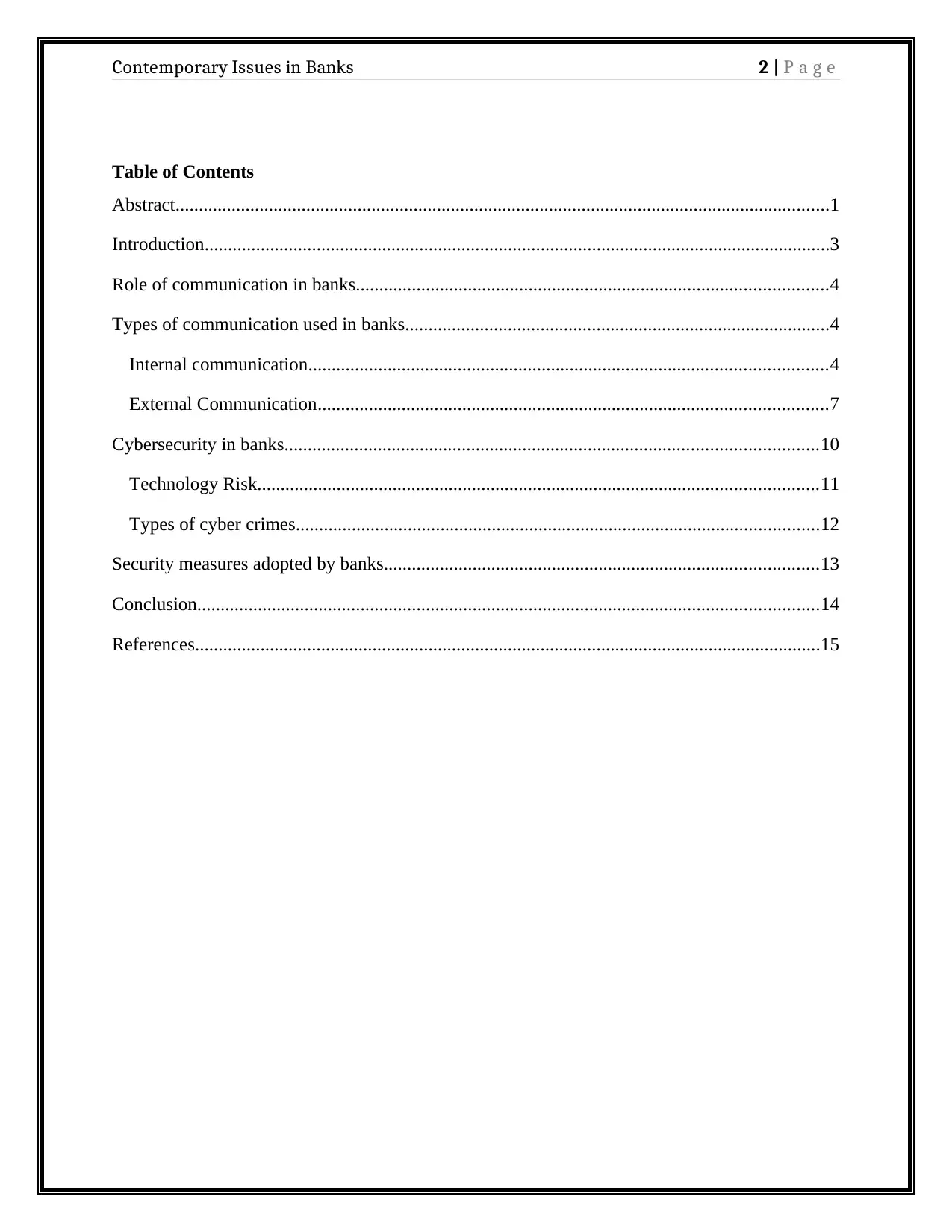
Table of Contents
Abstract............................................................................................................................................1
Introduction......................................................................................................................................3
Role of communication in banks.....................................................................................................4
Types of communication used in banks...........................................................................................4
Internal communication...............................................................................................................4
External Communication.............................................................................................................7
Cybersecurity in banks..................................................................................................................10
Technology Risk........................................................................................................................11
Types of cyber crimes................................................................................................................12
Security measures adopted by banks.............................................................................................13
Conclusion.....................................................................................................................................14
References......................................................................................................................................15
⊘ This is a preview!⊘
Do you want full access?
Subscribe today to unlock all pages.

Trusted by 1+ million students worldwide
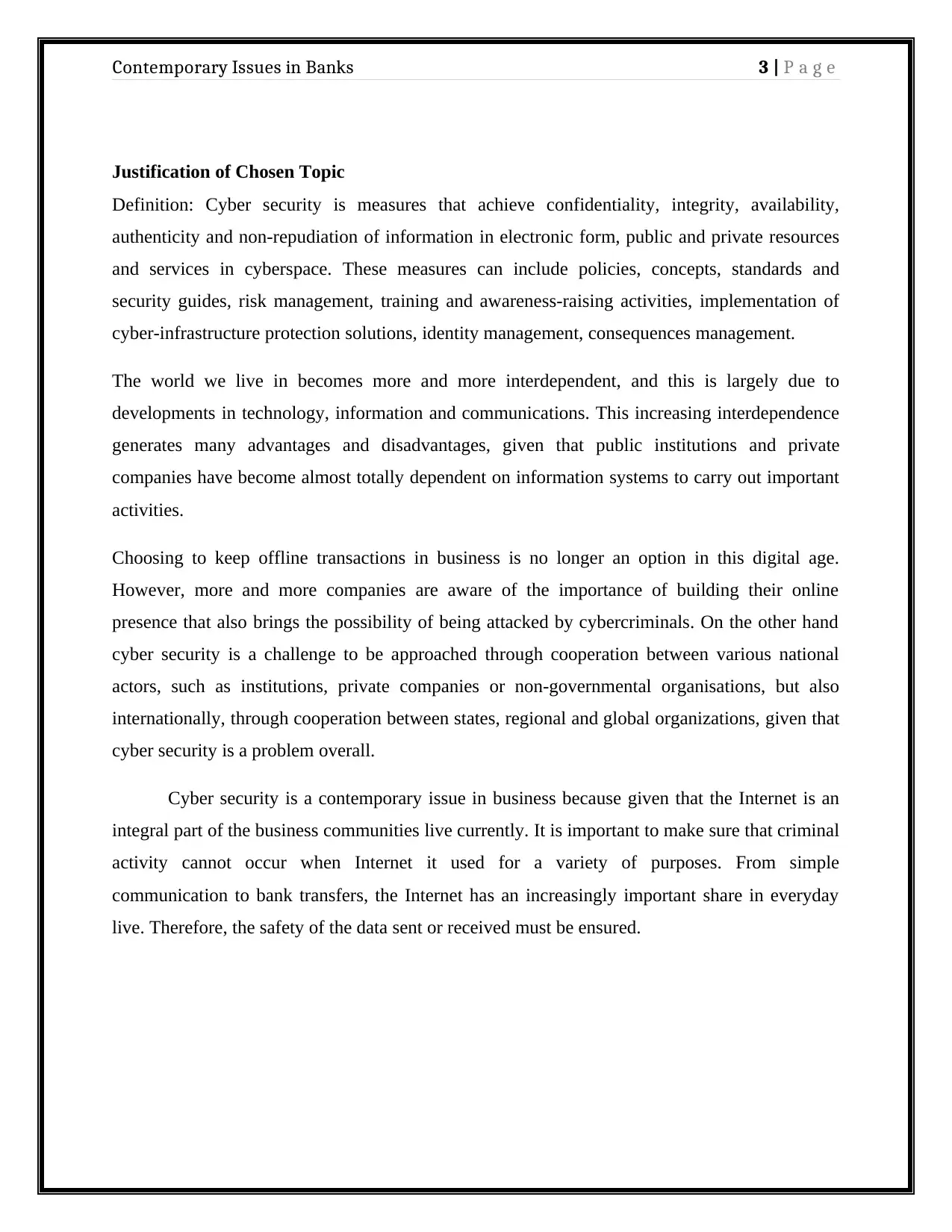
Justification of Chosen Topic
Definition: Cyber security is measures that achieve confidentiality, integrity, availability,
authenticity and non-repudiation of information in electronic form, public and private resources
and services in cyberspace. These measures can include policies, concepts, standards and
security guides, risk management, training and awareness-raising activities, implementation of
cyber-infrastructure protection solutions, identity management, consequences management.
The world we live in becomes more and more interdependent, and this is largely due to
developments in technology, information and communications. This increasing interdependence
generates many advantages and disadvantages, given that public institutions and private
companies have become almost totally dependent on information systems to carry out important
activities.
Choosing to keep offline transactions in business is no longer an option in this digital age.
However, more and more companies are aware of the importance of building their online
presence that also brings the possibility of being attacked by cybercriminals. On the other hand
cyber security is a challenge to be approached through cooperation between various national
actors, such as institutions, private companies or non-governmental organisations, but also
internationally, through cooperation between states, regional and global organizations, given that
cyber security is a problem overall.
Cyber security is a contemporary issue in business because given that the Internet is an
integral part of the business communities live currently. It is important to make sure that criminal
activity cannot occur when Internet it used for a variety of purposes. From simple
communication to bank transfers, the Internet has an increasingly important share in everyday
live. Therefore, the safety of the data sent or received must be ensured.
Paraphrase This Document
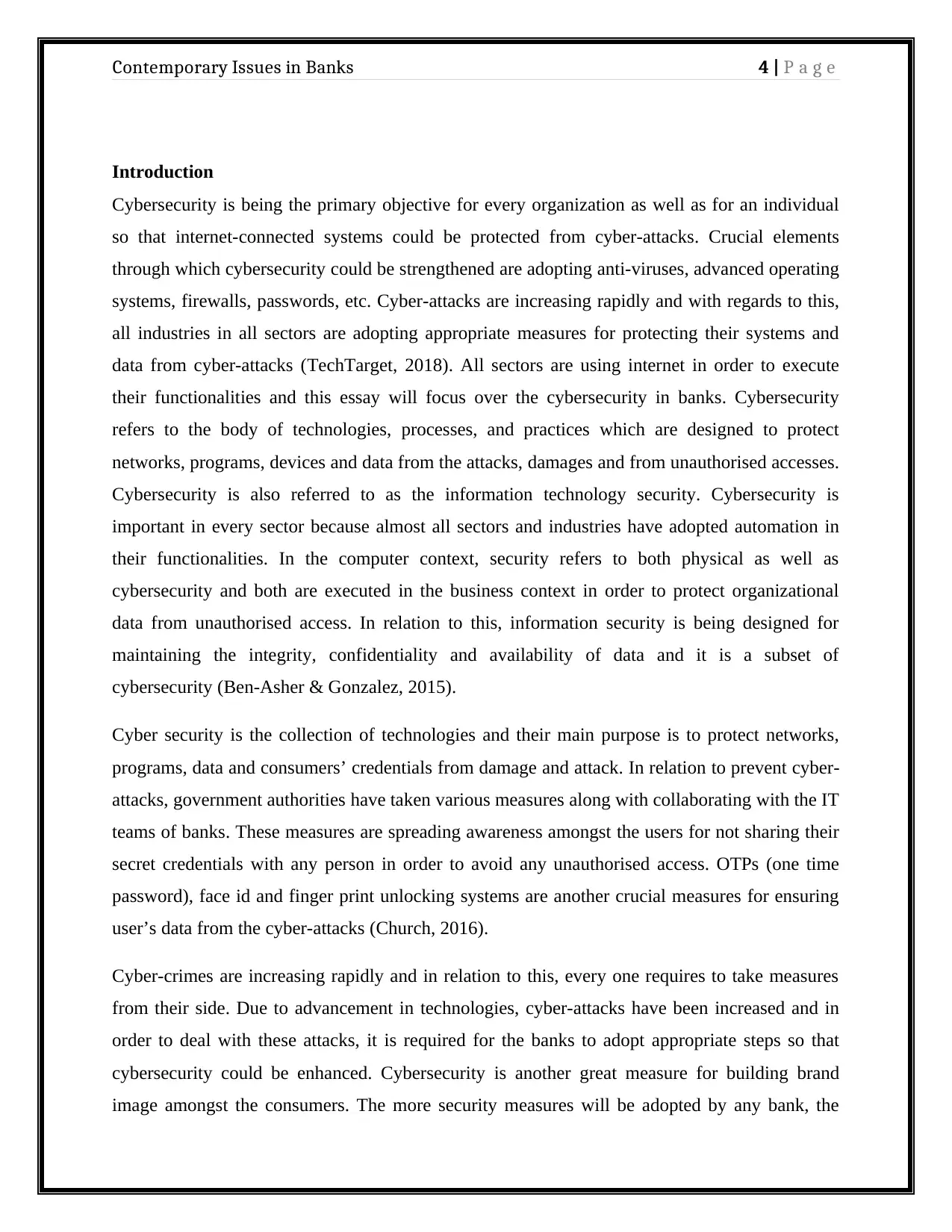
Introduction
Cybersecurity is being the primary objective for every organization as well as for an individual
so that internet-connected systems could be protected from cyber-attacks. Crucial elements
through which cybersecurity could be strengthened are adopting anti-viruses, advanced operating
systems, firewalls, passwords, etc. Cyber-attacks are increasing rapidly and with regards to this,
all industries in all sectors are adopting appropriate measures for protecting their systems and
data from cyber-attacks (TechTarget, 2018). All sectors are using internet in order to execute
their functionalities and this essay will focus over the cybersecurity in banks. Cybersecurity
refers to the body of technologies, processes, and practices which are designed to protect
networks, programs, devices and data from the attacks, damages and from unauthorised accesses.
Cybersecurity is also referred to as the information technology security. Cybersecurity is
important in every sector because almost all sectors and industries have adopted automation in
their functionalities. In the computer context, security refers to both physical as well as
cybersecurity and both are executed in the business context in order to protect organizational
data from unauthorised access. In relation to this, information security is being designed for
maintaining the integrity, confidentiality and availability of data and it is a subset of
cybersecurity (Ben-Asher & Gonzalez, 2015).
Cyber security is the collection of technologies and their main purpose is to protect networks,
programs, data and consumers’ credentials from damage and attack. In relation to prevent cyber-
attacks, government authorities have taken various measures along with collaborating with the IT
teams of banks. These measures are spreading awareness amongst the users for not sharing their
secret credentials with any person in order to avoid any unauthorised access. OTPs (one time
password), face id and finger print unlocking systems are another crucial measures for ensuring
user’s data from the cyber-attacks (Church, 2016).
Cyber-crimes are increasing rapidly and in relation to this, every one requires to take measures
from their side. Due to advancement in technologies, cyber-attacks have been increased and in
order to deal with these attacks, it is required for the banks to adopt appropriate steps so that
cybersecurity could be enhanced. Cybersecurity is another great measure for building brand
image amongst the consumers. The more security measures will be adopted by any bank, the
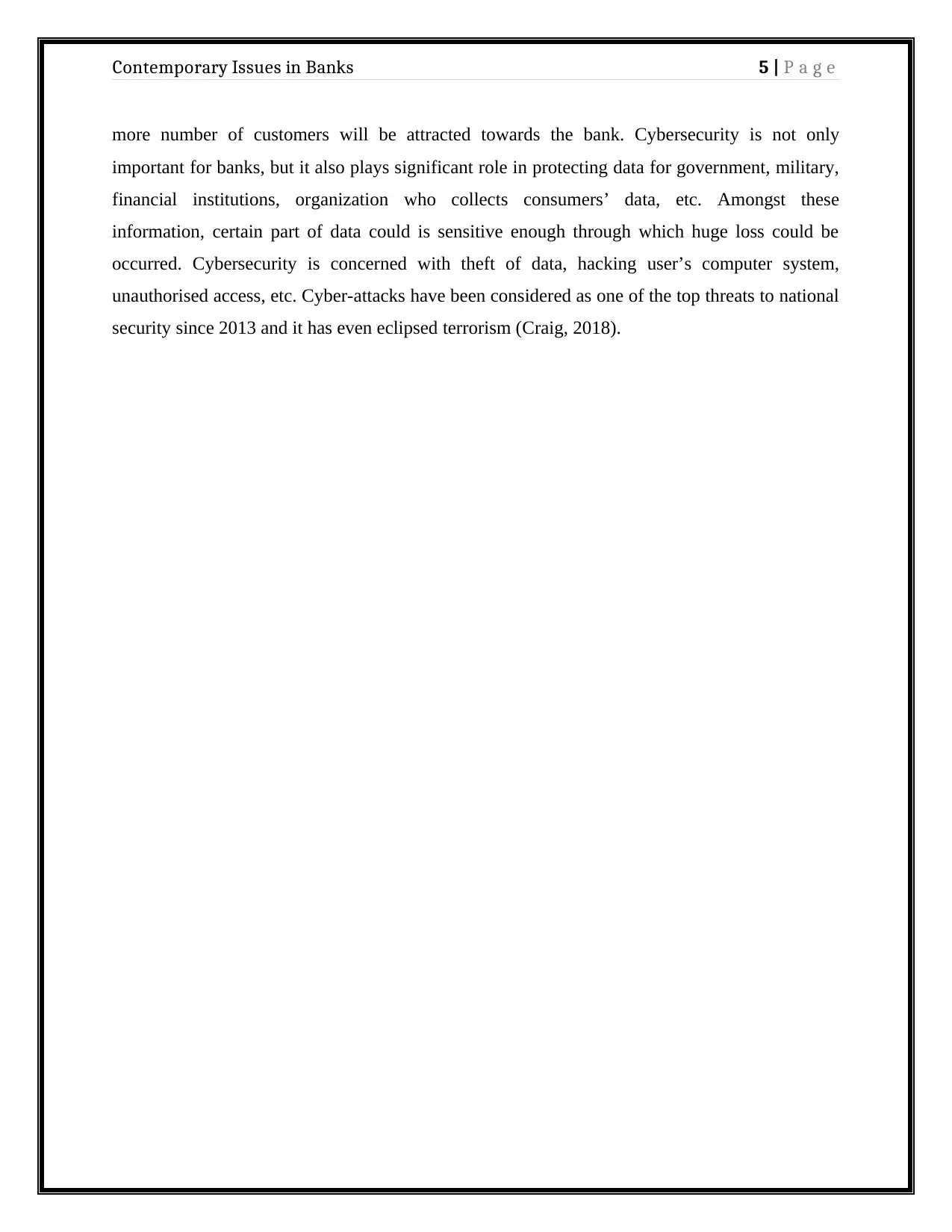
more number of customers will be attracted towards the bank. Cybersecurity is not only
important for banks, but it also plays significant role in protecting data for government, military,
financial institutions, organization who collects consumers’ data, etc. Amongst these
information, certain part of data could is sensitive enough through which huge loss could be
occurred. Cybersecurity is concerned with theft of data, hacking user’s computer system,
unauthorised access, etc. Cyber-attacks have been considered as one of the top threats to national
security since 2013 and it has even eclipsed terrorism (Craig, 2018).
⊘ This is a preview!⊘
Do you want full access?
Subscribe today to unlock all pages.

Trusted by 1+ million students worldwide
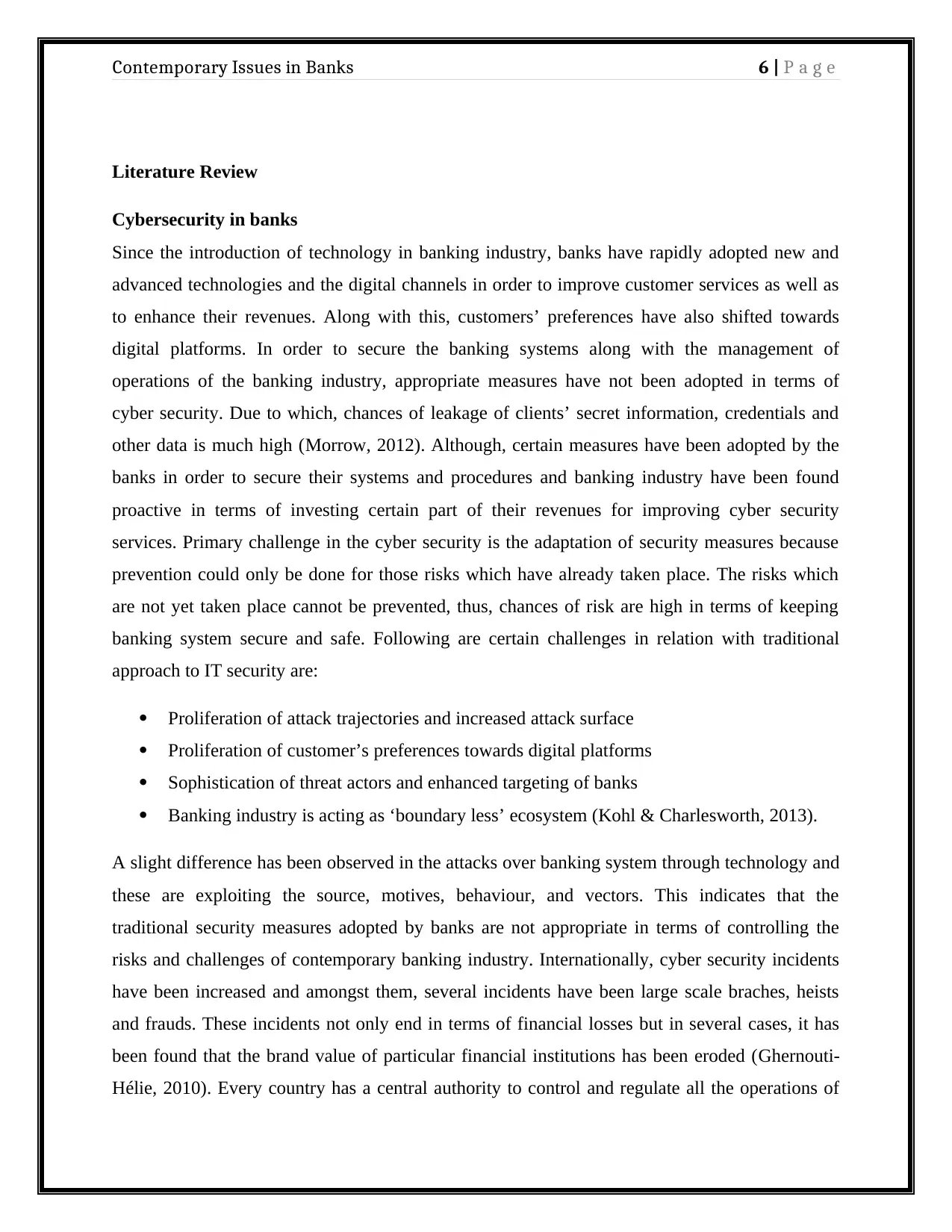
Literature Review
Cybersecurity in banks
Since the introduction of technology in banking industry, banks have rapidly adopted new and
advanced technologies and the digital channels in order to improve customer services as well as
to enhance their revenues. Along with this, customers’ preferences have also shifted towards
digital platforms. In order to secure the banking systems along with the management of
operations of the banking industry, appropriate measures have not been adopted in terms of
cyber security. Due to which, chances of leakage of clients’ secret information, credentials and
other data is much high (Morrow, 2012). Although, certain measures have been adopted by the
banks in order to secure their systems and procedures and banking industry have been found
proactive in terms of investing certain part of their revenues for improving cyber security
services. Primary challenge in the cyber security is the adaptation of security measures because
prevention could only be done for those risks which have already taken place. The risks which
are not yet taken place cannot be prevented, thus, chances of risk are high in terms of keeping
banking system secure and safe. Following are certain challenges in relation with traditional
approach to IT security are:
Proliferation of attack trajectories and increased attack surface
Proliferation of customer’s preferences towards digital platforms
Sophistication of threat actors and enhanced targeting of banks
Banking industry is acting as ‘boundary less’ ecosystem (Kohl & Charlesworth, 2013).
A slight difference has been observed in the attacks over banking system through technology and
these are exploiting the source, motives, behaviour, and vectors. This indicates that the
traditional security measures adopted by banks are not appropriate in terms of controlling the
risks and challenges of contemporary banking industry. Internationally, cyber security incidents
have been increased and amongst them, several incidents have been large scale braches, heists
and frauds. These incidents not only end in terms of financial losses but in several cases, it has
been found that the brand value of particular financial institutions has been eroded (Ghernouti-
Hélie, 2010). Every country has a central authority to control and regulate all the operations of
Paraphrase This Document

financial institutions and banks. With regards to this, they have adopted several measures in the
direction of controlling the cyber-attacks over banks. Along with this, they have also adopted
advanced technological measures for strengthen bank’s cyber security so that banks could easily
be able to control the losses occurred due to unwanted incidents along with analysing the nature
and quantum of cyber-attacks (Gcaza & von Solms, 2017).
Elements of cybersecurity
For executing cybersecurity in an effective manner, appropriate coordination and efforts are
required throughout an information system and it includes:
Application security
Information security
Network security
Disaster recovery
Operational security
Amongst these elements, one of the elements is constantly affecting cybersecurity and it is
evolving nature of security risks. Traditional approach of cybersecurity focus on preventing
system components against the major threats which meant leaving components undefended and
not protecting system against less dangerous risks (Terlizzi, Meirelles & & Viegas Cortez da
Cunha, 2017). Advisory organizations in cybersecurity plays vital role and as per the current
environment, they suggest to promote more proactive and adaptive approach. The National
Institute of Standards and Technology (NIST) have recently issued updated guidelines in relation
with risk assessment framework that recommend a shift towards real-time assessments and
continuous monitoring. These frameworks are mainly introduced for improving critical
infrastructure and amongst them, a framework is mainly introduced for protecting data theft and
other cyber-attacks in banking, communication, defines and energy industries. Thus, investments
in cybersecurity are increasing in order to upgrade the technologies through which enhance the
level of cybersecurity (NIST, 2018).
Cyber-attacks in banks
Bank robbery is one of the oldest crimes which are being practiced since a very long time. When
internet was not introduced, traditional methods were used for bank robbery and all those did not
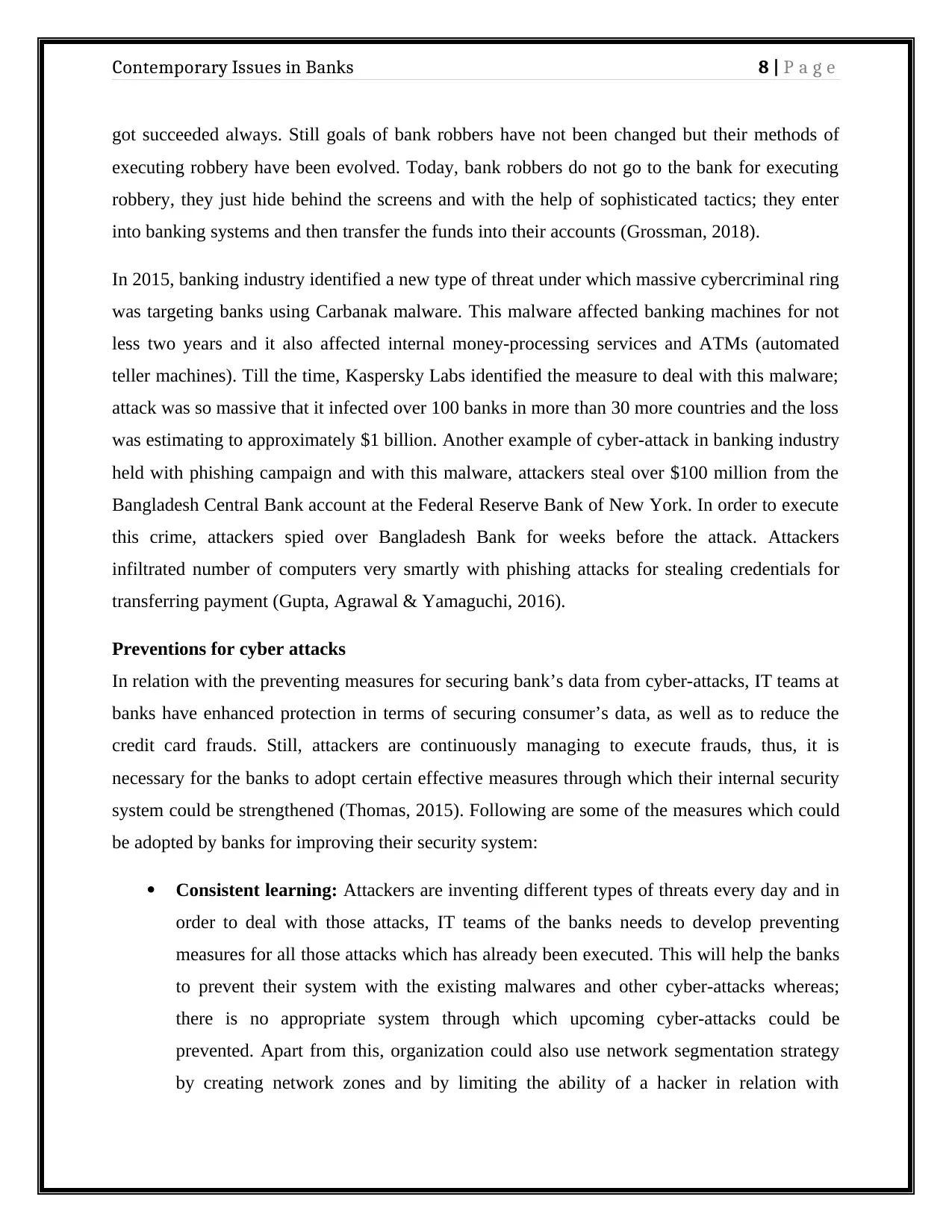
got succeeded always. Still goals of bank robbers have not been changed but their methods of
executing robbery have been evolved. Today, bank robbers do not go to the bank for executing
robbery, they just hide behind the screens and with the help of sophisticated tactics; they enter
into banking systems and then transfer the funds into their accounts (Grossman, 2018).
In 2015, banking industry identified a new type of threat under which massive cybercriminal ring
was targeting banks using Carbanak malware. This malware affected banking machines for not
less two years and it also affected internal money-processing services and ATMs (automated
teller machines). Till the time, Kaspersky Labs identified the measure to deal with this malware;
attack was so massive that it infected over 100 banks in more than 30 more countries and the loss
was estimating to approximately $1 billion. Another example of cyber-attack in banking industry
held with phishing campaign and with this malware, attackers steal over $100 million from the
Bangladesh Central Bank account at the Federal Reserve Bank of New York. In order to execute
this crime, attackers spied over Bangladesh Bank for weeks before the attack. Attackers
infiltrated number of computers very smartly with phishing attacks for stealing credentials for
transferring payment (Gupta, Agrawal & Yamaguchi, 2016).
Preventions for cyber attacks
In relation with the preventing measures for securing bank’s data from cyber-attacks, IT teams at
banks have enhanced protection in terms of securing consumer’s data, as well as to reduce the
credit card frauds. Still, attackers are continuously managing to execute frauds, thus, it is
necessary for the banks to adopt certain effective measures through which their internal security
system could be strengthened (Thomas, 2015). Following are some of the measures which could
be adopted by banks for improving their security system:
Consistent learning: Attackers are inventing different types of threats every day and in
order to deal with those attacks, IT teams of the banks needs to develop preventing
measures for all those attacks which has already been executed. This will help the banks
to prevent their system with the existing malwares and other cyber-attacks whereas;
there is no appropriate system through which upcoming cyber-attacks could be
prevented. Apart from this, organization could also use network segmentation strategy
by creating network zones and by limiting the ability of a hacker in relation with
⊘ This is a preview!⊘
Do you want full access?
Subscribe today to unlock all pages.

Trusted by 1+ million students worldwide
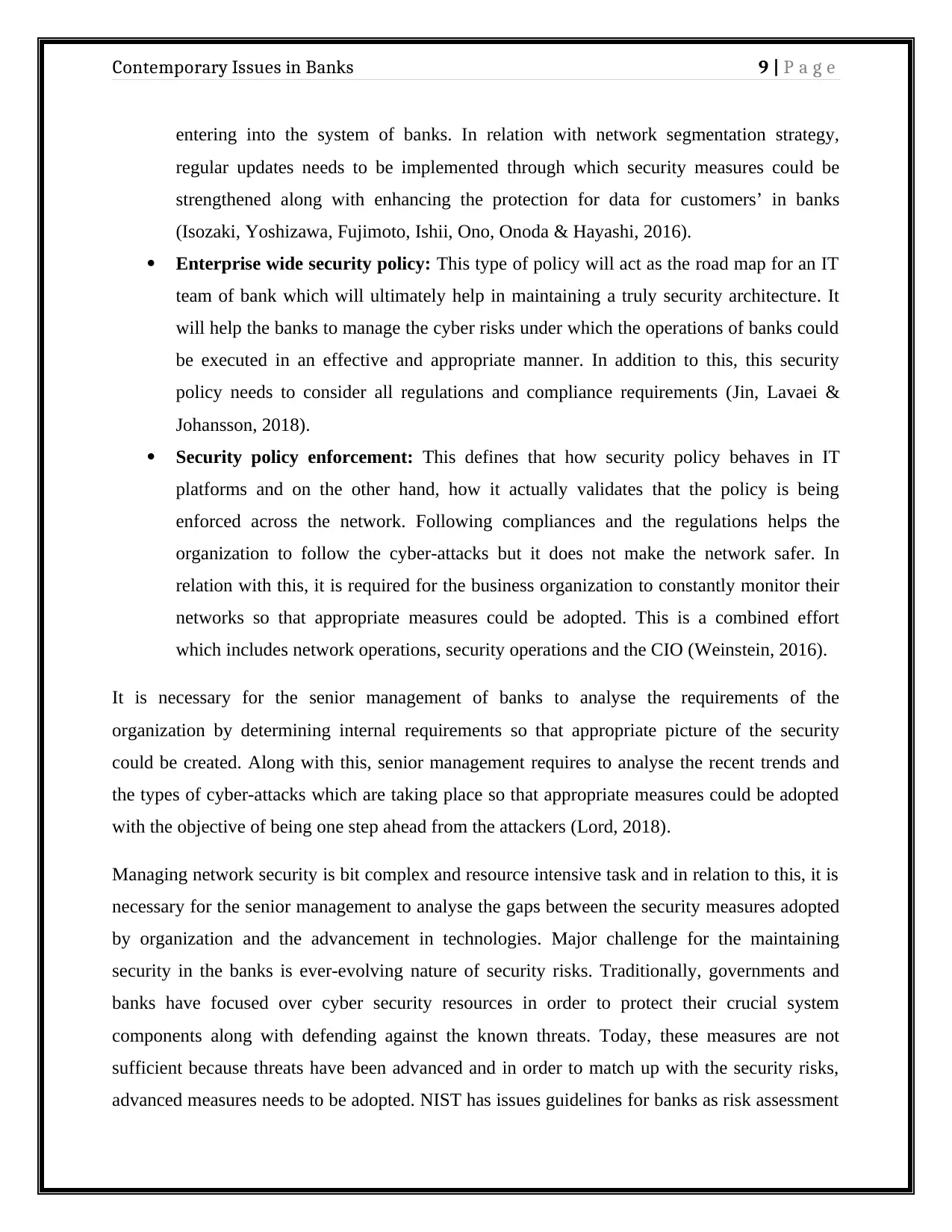
entering into the system of banks. In relation with network segmentation strategy,
regular updates needs to be implemented through which security measures could be
strengthened along with enhancing the protection for data for customers’ in banks
(Isozaki, Yoshizawa, Fujimoto, Ishii, Ono, Onoda & Hayashi, 2016).
Enterprise wide security policy: This type of policy will act as the road map for an IT
team of bank which will ultimately help in maintaining a truly security architecture. It
will help the banks to manage the cyber risks under which the operations of banks could
be executed in an effective and appropriate manner. In addition to this, this security
policy needs to consider all regulations and compliance requirements (Jin, Lavaei &
Johansson, 2018).
Security policy enforcement: This defines that how security policy behaves in IT
platforms and on the other hand, how it actually validates that the policy is being
enforced across the network. Following compliances and the regulations helps the
organization to follow the cyber-attacks but it does not make the network safer. In
relation with this, it is required for the business organization to constantly monitor their
networks so that appropriate measures could be adopted. This is a combined effort
which includes network operations, security operations and the CIO (Weinstein, 2016).
It is necessary for the senior management of banks to analyse the requirements of the
organization by determining internal requirements so that appropriate picture of the security
could be created. Along with this, senior management requires to analyse the recent trends and
the types of cyber-attacks which are taking place so that appropriate measures could be adopted
with the objective of being one step ahead from the attackers (Lord, 2018).
Managing network security is bit complex and resource intensive task and in relation to this, it is
necessary for the senior management to analyse the gaps between the security measures adopted
by organization and the advancement in technologies. Major challenge for the maintaining
security in the banks is ever-evolving nature of security risks. Traditionally, governments and
banks have focused over cyber security resources in order to protect their crucial system
components along with defending against the known threats. Today, these measures are not
sufficient because threats have been advanced and in order to match up with the security risks,
advanced measures needs to be adopted. NIST has issues guidelines for banks as risk assessment
Paraphrase This Document
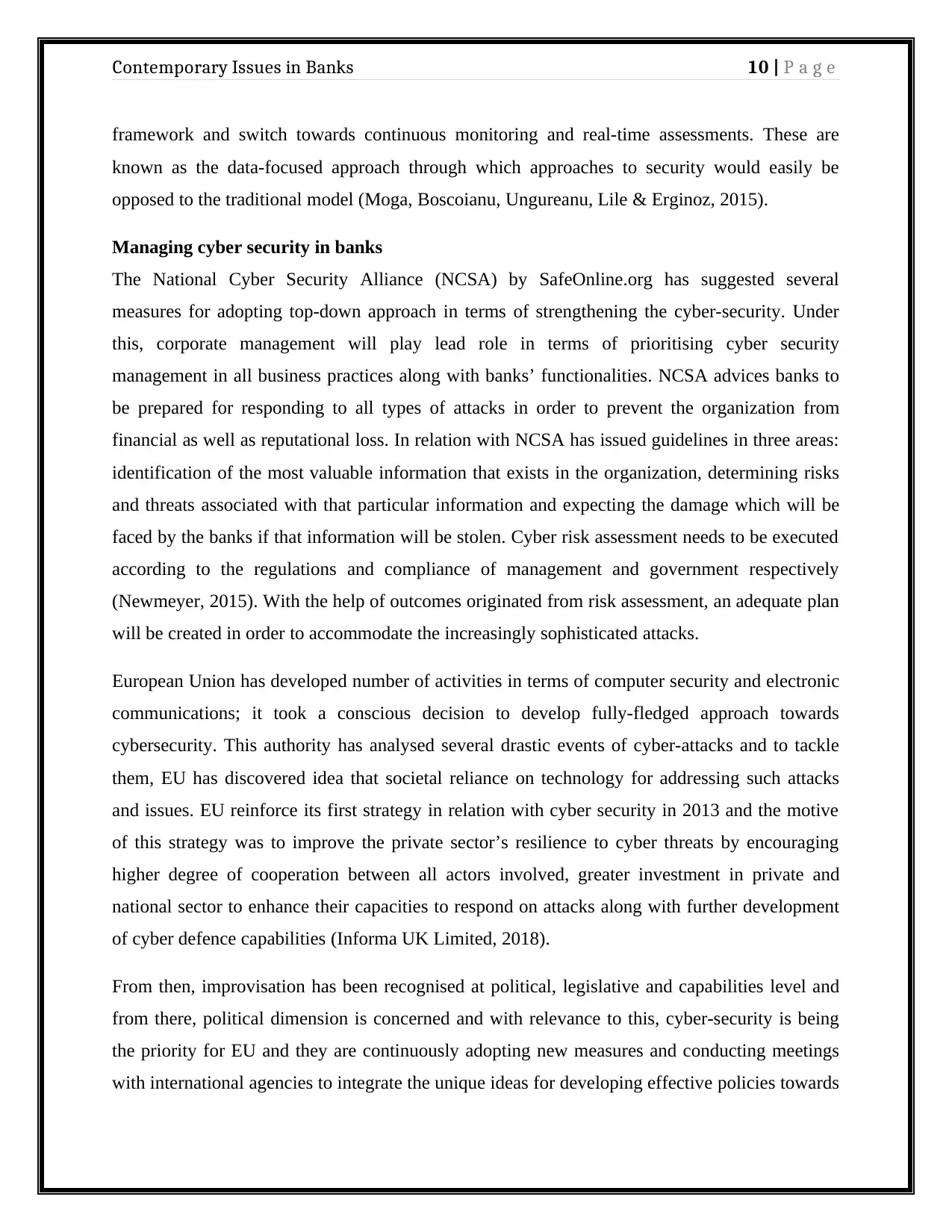
framework and switch towards continuous monitoring and real-time assessments. These are
known as the data-focused approach through which approaches to security would easily be
opposed to the traditional model (Moga, Boscoianu, Ungureanu, Lile & Erginoz, 2015).
Managing cyber security in banks
The National Cyber Security Alliance (NCSA) by SafeOnline.org has suggested several
measures for adopting top-down approach in terms of strengthening the cyber-security. Under
this, corporate management will play lead role in terms of prioritising cyber security
management in all business practices along with banks’ functionalities. NCSA advices banks to
be prepared for responding to all types of attacks in order to prevent the organization from
financial as well as reputational loss. In relation with NCSA has issued guidelines in three areas:
identification of the most valuable information that exists in the organization, determining risks
and threats associated with that particular information and expecting the damage which will be
faced by the banks if that information will be stolen. Cyber risk assessment needs to be executed
according to the regulations and compliance of management and government respectively
(Newmeyer, 2015). With the help of outcomes originated from risk assessment, an adequate plan
will be created in order to accommodate the increasingly sophisticated attacks.
European Union has developed number of activities in terms of computer security and electronic
communications; it took a conscious decision to develop fully-fledged approach towards
cybersecurity. This authority has analysed several drastic events of cyber-attacks and to tackle
them, EU has discovered idea that societal reliance on technology for addressing such attacks
and issues. EU reinforce its first strategy in relation with cyber security in 2013 and the motive
of this strategy was to improve the private sector’s resilience to cyber threats by encouraging
higher degree of cooperation between all actors involved, greater investment in private and
national sector to enhance their capacities to respond on attacks along with further development
of cyber defence capabilities (Informa UK Limited, 2018).
From then, improvisation has been recognised at political, legislative and capabilities level and
from there, political dimension is concerned and with relevance to this, cyber-security is being
the priority for EU and they are continuously adopting new measures and conducting meetings
with international agencies to integrate the unique ideas for developing effective policies towards

improving cyber-security. Primary motive of cyber-security is being one step ahead from the
hackers and to attain this objective, EU has invested huge part of their earnings towards research
and development so that the members of this team could think out of the box in terms of
secreting the banking system especially from the cyber-attacks (No & Vasarhelyi, 2017).
Technology Risk
From the all major concerns, outdated core IT system was the most significant threat for global
bankers. Failures are the major reason for investing in terms of enhancing the procedures along
with keeping the banking system secure through which the quality of service could be improved
as well as the adaptation of agile systems through which digital and mobile banking system
could be enhanced in terms of controlling and to face the cyber-attacks in an appropriate manner
(Wilson, 2011). Along with the cyber-attacks, other reasons which affect organizational
performance are burden of multiple legacy systems at some banks is another crucial problem. In
addition to this, several banks especially those who practice with traditional approaches face
huge competition from the disruptive innovators who are providing high quality services to its
clients. This makes the modern banking industry unique from the traditional banking industry. In
terms of enhancing the organizational performance, adaptation of change is necessary (Pan,
Morris & Adhikari, 2015). Change management helps the organization to deal with the
contemporary requirements of the business industry as well as of the target audience. With
regards to this, banks are required to adopt innovative and creative approaches to make their
operations unique from the other banks and financial institutions (Sales, 2012).
Technological risks directly linked with the criminality and cyber-attacks are some of the
important concerns for bankers. It has been analysed that banks technology has grown and along
with this, threat of cyber-attacks have also been increased. With regards to the cyber-attacks,
prevention measures are not yet capable enough to stay one step ahead from the threats.
Measures are only available for those activities which have already been taken place. There are
not such measures are available through which the risk of cyber-attacks could be minimised.
Professional hackers, fraud companies, etc. are major threat for the banking system (Zhuang,
Bardas, DeLoach & Ou, 2015). Cyberattacks on key financial infrastructure could leave banks
vulnerable to significant financial, regulatory, and reputational risk. These attacks have been
immensely grown up in last couple of years and to respond positively towards these growing
⊘ This is a preview!⊘
Do you want full access?
Subscribe today to unlock all pages.

Trusted by 1+ million students worldwide
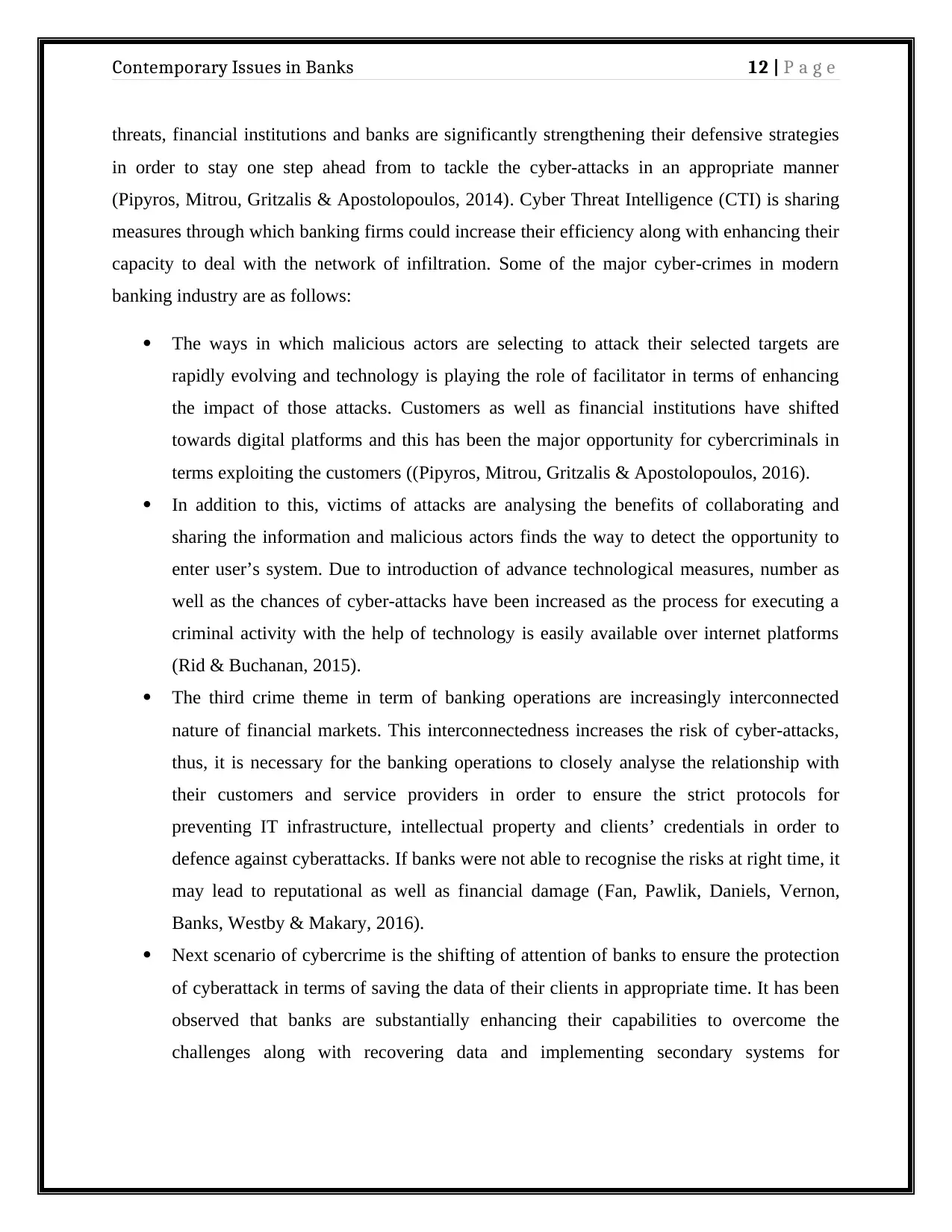
threats, financial institutions and banks are significantly strengthening their defensive strategies
in order to stay one step ahead from to tackle the cyber-attacks in an appropriate manner
(Pipyros, Mitrou, Gritzalis & Apostolopoulos, 2014). Cyber Threat Intelligence (CTI) is sharing
measures through which banking firms could increase their efficiency along with enhancing their
capacity to deal with the network of infiltration. Some of the major cyber-crimes in modern
banking industry are as follows:
The ways in which malicious actors are selecting to attack their selected targets are
rapidly evolving and technology is playing the role of facilitator in terms of enhancing
the impact of those attacks. Customers as well as financial institutions have shifted
towards digital platforms and this has been the major opportunity for cybercriminals in
terms exploiting the customers ((Pipyros, Mitrou, Gritzalis & Apostolopoulos, 2016).
In addition to this, victims of attacks are analysing the benefits of collaborating and
sharing the information and malicious actors finds the way to detect the opportunity to
enter user’s system. Due to introduction of advance technological measures, number as
well as the chances of cyber-attacks have been increased as the process for executing a
criminal activity with the help of technology is easily available over internet platforms
(Rid & Buchanan, 2015).
The third crime theme in term of banking operations are increasingly interconnected
nature of financial markets. This interconnectedness increases the risk of cyber-attacks,
thus, it is necessary for the banking operations to closely analyse the relationship with
their customers and service providers in order to ensure the strict protocols for
preventing IT infrastructure, intellectual property and clients’ credentials in order to
defence against cyberattacks. If banks were not able to recognise the risks at right time, it
may lead to reputational as well as financial damage (Fan, Pawlik, Daniels, Vernon,
Banks, Westby & Makary, 2016).
Next scenario of cybercrime is the shifting of attention of banks to ensure the protection
of cyberattack in terms of saving the data of their clients in appropriate time. It has been
observed that banks are substantially enhancing their capabilities to overcome the
challenges along with recovering data and implementing secondary systems for
Paraphrase This Document

maintaining the operations in the event of prevention of cyberattack (Rasekh,
Hassanzadeh, Mulchandani, Modi & Banks, 2016).
With regards to this, banking firms are implementing new and advanced technologies as well as
the traditional methods as defensive strategies. Combination of these strategies proves to be the
most appropriate and effective strategies for developing security program. This also includes
strong management process through which every attack could easily be faced along with the
vulnerability management (Servidio & Taylor, 2015). Advancement of computers and
technology in business sector as well as in other sectors has eased the operations and along with
this, it has also generated various risk factors due to which cybercrimes and threats increases
rapidly (Weinstein, 2016). Role of computers and technology is huge in terms of executing the
destructive operations. Banking sector include, public banks, private banks, foreign banks,
regional as well as cooperative banks. In relation to this, various IT based products and services
are available. Some of them are phone banking, ATM, Smart cards, debit and credit card, mobile
banking, internet banking and there are various other banking services through which banking
industry has created an effective place in an individual’s life (Carr, 2016).
Types of cybersecurity threats
Computer crime, high tech crime, e-crime, digital crime, and cybercrime are certain crucial terms
of electronic crime. In terms of executing e-crimes, computer plays vital role in relation with
committing crime, as the tool to store the data and as the target of the crime. Stolen of
intellectual property or execution of any illegal activity could easily be done with the help of
computers. In order to match up with the latest trends in technologies, security measures and
threat intelligence, advisory organizations are required to be active (Shields, 2015). Culprits
could execute several types of cybercrimes and the most common are:
Ransomware: It is a type of malware under which an attacker locks victim’s computer
system and files stored in the computer. This is done through encryption and against
unlocking the system, attacker demands for payment to decrypt and for unlocking the
victim’s computer.
Malware: This is a type of threat which is used for harming computer user such as
computer virus, worms, spyware, etc. (Shoemaker, Kohnke & Sigler, 2016).
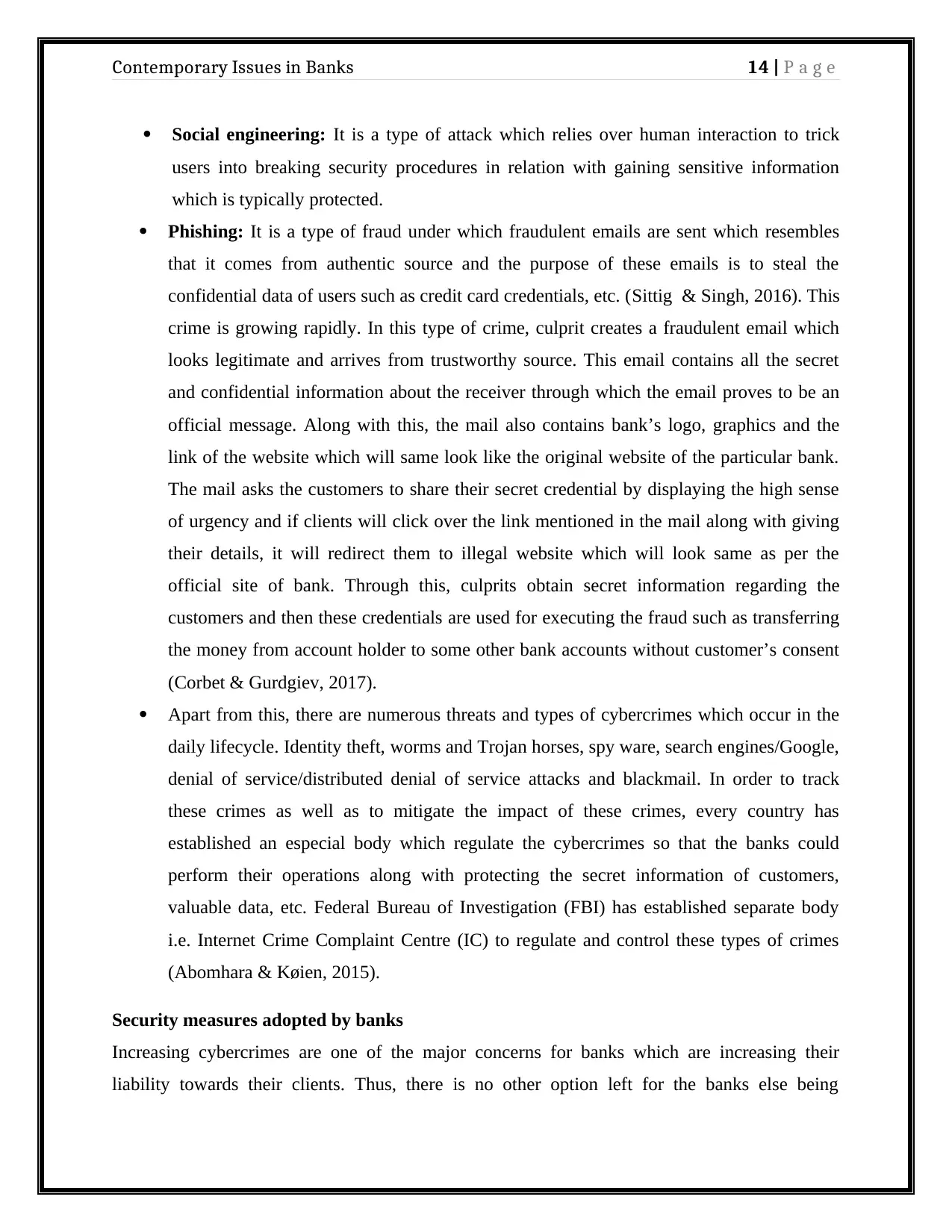
Social engineering: It is a type of attack which relies over human interaction to trick
users into breaking security procedures in relation with gaining sensitive information
which is typically protected.
Phishing: It is a type of fraud under which fraudulent emails are sent which resembles
that it comes from authentic source and the purpose of these emails is to steal the
confidential data of users such as credit card credentials, etc. (Sittig & Singh, 2016). This
crime is growing rapidly. In this type of crime, culprit creates a fraudulent email which
looks legitimate and arrives from trustworthy source. This email contains all the secret
and confidential information about the receiver through which the email proves to be an
official message. Along with this, the mail also contains bank’s logo, graphics and the
link of the website which will same look like the original website of the particular bank.
The mail asks the customers to share their secret credential by displaying the high sense
of urgency and if clients will click over the link mentioned in the mail along with giving
their details, it will redirect them to illegal website which will look same as per the
official site of bank. Through this, culprits obtain secret information regarding the
customers and then these credentials are used for executing the fraud such as transferring
the money from account holder to some other bank accounts without customer’s consent
(Corbet & Gurdgiev, 2017).
Apart from this, there are numerous threats and types of cybercrimes which occur in the
daily lifecycle. Identity theft, worms and Trojan horses, spy ware, search engines/Google,
denial of service/distributed denial of service attacks and blackmail. In order to track
these crimes as well as to mitigate the impact of these crimes, every country has
established an especial body which regulate the cybercrimes so that the banks could
perform their operations along with protecting the secret information of customers,
valuable data, etc. Federal Bureau of Investigation (FBI) has established separate body
i.e. Internet Crime Complaint Centre (IC) to regulate and control these types of crimes
(Abomhara & Køien, 2015).
Security measures adopted by banks
Increasing cybercrimes are one of the major concerns for banks which are increasing their
liability towards their clients. Thus, there is no other option left for the banks else being
⊘ This is a preview!⊘
Do you want full access?
Subscribe today to unlock all pages.

Trusted by 1+ million students worldwide
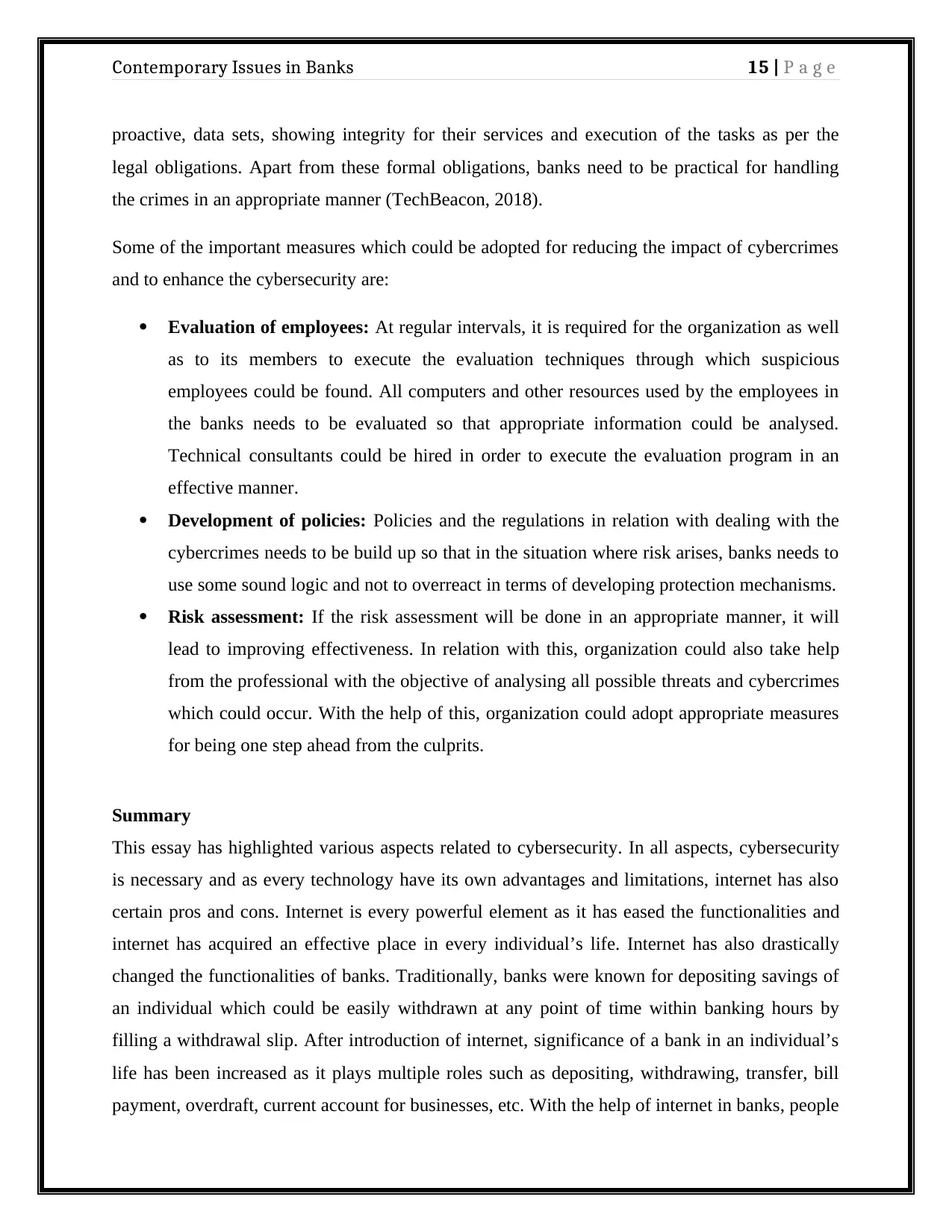
proactive, data sets, showing integrity for their services and execution of the tasks as per the
legal obligations. Apart from these formal obligations, banks need to be practical for handling
the crimes in an appropriate manner (TechBeacon, 2018).
Some of the important measures which could be adopted for reducing the impact of cybercrimes
and to enhance the cybersecurity are:
Evaluation of employees: At regular intervals, it is required for the organization as well
as to its members to execute the evaluation techniques through which suspicious
employees could be found. All computers and other resources used by the employees in
the banks needs to be evaluated so that appropriate information could be analysed.
Technical consultants could be hired in order to execute the evaluation program in an
effective manner.
Development of policies: Policies and the regulations in relation with dealing with the
cybercrimes needs to be build up so that in the situation where risk arises, banks needs to
use some sound logic and not to overreact in terms of developing protection mechanisms.
Risk assessment: If the risk assessment will be done in an appropriate manner, it will
lead to improving effectiveness. In relation with this, organization could also take help
from the professional with the objective of analysing all possible threats and cybercrimes
which could occur. With the help of this, organization could adopt appropriate measures
for being one step ahead from the culprits.
Summary
This essay has highlighted various aspects related to cybersecurity. In all aspects, cybersecurity
is necessary and as every technology have its own advantages and limitations, internet has also
certain pros and cons. Internet is every powerful element as it has eased the functionalities and
internet has acquired an effective place in every individual’s life. Internet has also drastically
changed the functionalities of banks. Traditionally, banks were known for depositing savings of
an individual which could be easily withdrawn at any point of time within banking hours by
filling a withdrawal slip. After introduction of internet, significance of a bank in an individual’s
life has been increased as it plays multiple roles such as depositing, withdrawing, transfer, bill
payment, overdraft, current account for businesses, etc. With the help of internet in banks, people
Paraphrase This Document
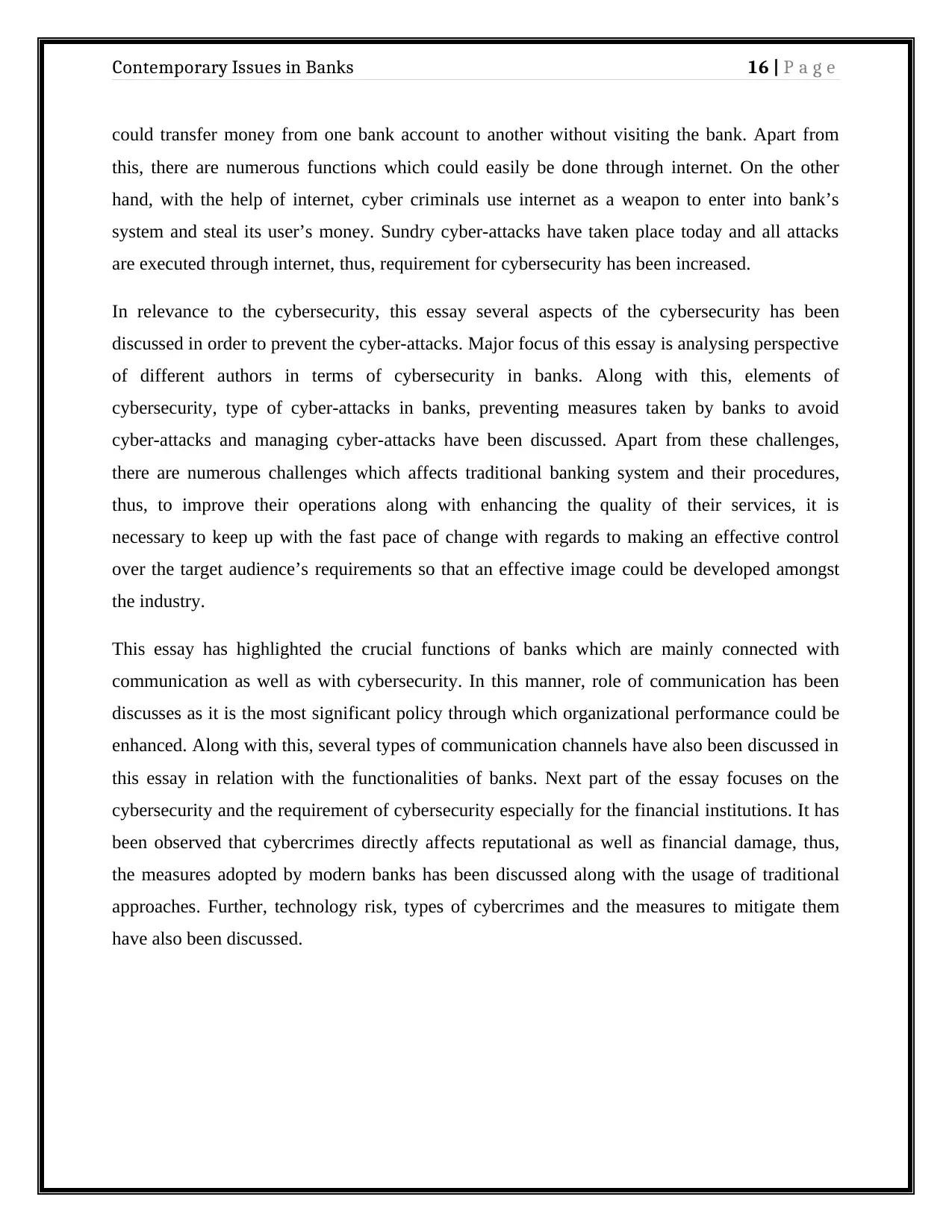
could transfer money from one bank account to another without visiting the bank. Apart from
this, there are numerous functions which could easily be done through internet. On the other
hand, with the help of internet, cyber criminals use internet as a weapon to enter into bank’s
system and steal its user’s money. Sundry cyber-attacks have taken place today and all attacks
are executed through internet, thus, requirement for cybersecurity has been increased.
In relevance to the cybersecurity, this essay several aspects of the cybersecurity has been
discussed in order to prevent the cyber-attacks. Major focus of this essay is analysing perspective
of different authors in terms of cybersecurity in banks. Along with this, elements of
cybersecurity, type of cyber-attacks in banks, preventing measures taken by banks to avoid
cyber-attacks and managing cyber-attacks have been discussed. Apart from these challenges,
there are numerous challenges which affects traditional banking system and their procedures,
thus, to improve their operations along with enhancing the quality of their services, it is
necessary to keep up with the fast pace of change with regards to making an effective control
over the target audience’s requirements so that an effective image could be developed amongst
the industry.
This essay has highlighted the crucial functions of banks which are mainly connected with
communication as well as with cybersecurity. In this manner, role of communication has been
discusses as it is the most significant policy through which organizational performance could be
enhanced. Along with this, several types of communication channels have also been discussed in
this essay in relation with the functionalities of banks. Next part of the essay focuses on the
cybersecurity and the requirement of cybersecurity especially for the financial institutions. It has
been observed that cybercrimes directly affects reputational as well as financial damage, thus,
the measures adopted by modern banks has been discussed along with the usage of traditional
approaches. Further, technology risk, types of cybercrimes and the measures to mitigate them
have also been discussed.
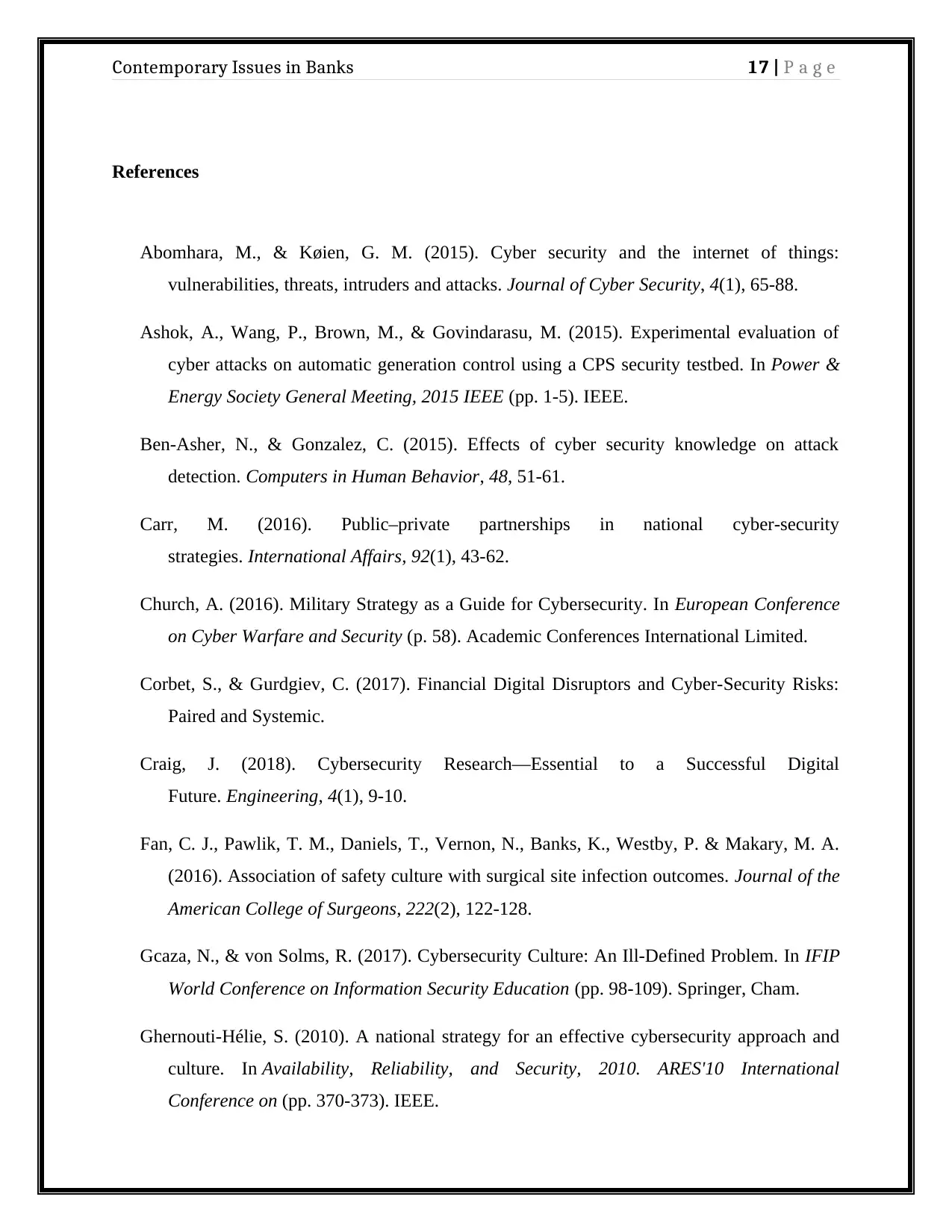
References
Abomhara, M., & Køien, G. M. (2015). Cyber security and the internet of things:
vulnerabilities, threats, intruders and attacks. Journal of Cyber Security, 4(1), 65-88.
Ashok, A., Wang, P., Brown, M., & Govindarasu, M. (2015). Experimental evaluation of
cyber attacks on automatic generation control using a CPS security testbed. In Power &
Energy Society General Meeting, 2015 IEEE (pp. 1-5). IEEE.
Ben-Asher, N., & Gonzalez, C. (2015). Effects of cyber security knowledge on attack
detection. Computers in Human Behavior, 48, 51-61.
Carr, M. (2016). Public–private partnerships in national cyber-security
strategies. International Affairs, 92(1), 43-62.
Church, A. (2016). Military Strategy as a Guide for Cybersecurity. In European Conference
on Cyber Warfare and Security (p. 58). Academic Conferences International Limited.
Corbet, S., & Gurdgiev, C. (2017). Financial Digital Disruptors and Cyber-Security Risks:
Paired and Systemic.
Craig, J. (2018). Cybersecurity Research—Essential to a Successful Digital
Future. Engineering, 4(1), 9-10.
Fan, C. J., Pawlik, T. M., Daniels, T., Vernon, N., Banks, K., Westby, P. & Makary, M. A.
(2016). Association of safety culture with surgical site infection outcomes. Journal of the
American College of Surgeons, 222(2), 122-128.
Gcaza, N., & von Solms, R. (2017). Cybersecurity Culture: An Ill-Defined Problem. In IFIP
World Conference on Information Security Education (pp. 98-109). Springer, Cham.
Ghernouti-Hélie, S. (2010). A national strategy for an effective cybersecurity approach and
culture. In Availability, Reliability, and Security, 2010. ARES'10 International
Conference on (pp. 370-373). IEEE.
⊘ This is a preview!⊘
Do you want full access?
Subscribe today to unlock all pages.

Trusted by 1+ million students worldwide
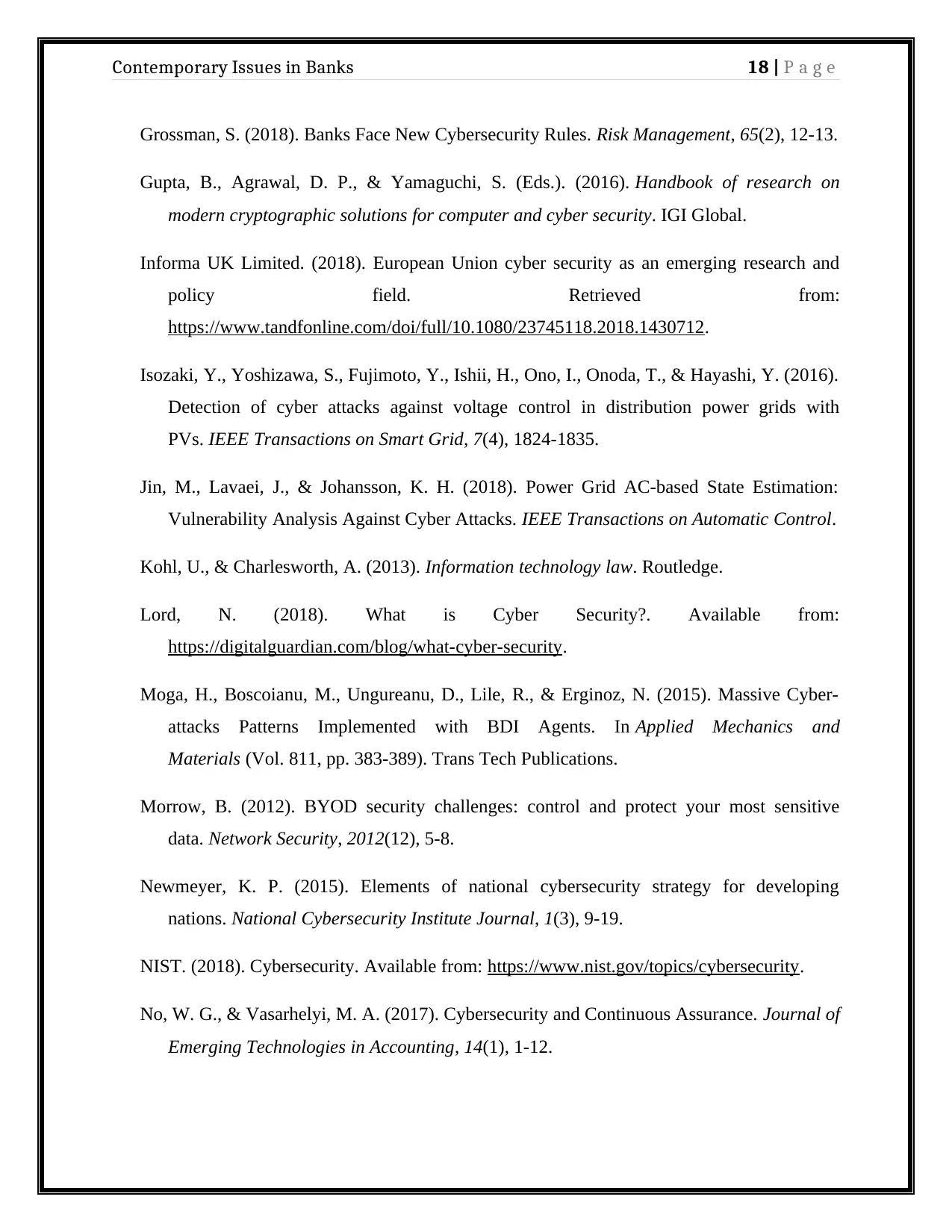
Grossman, S. (2018). Banks Face New Cybersecurity Rules. Risk Management, 65(2), 12-13.
Gupta, B., Agrawal, D. P., & Yamaguchi, S. (Eds.). (2016). Handbook of research on
modern cryptographic solutions for computer and cyber security. IGI Global.
Informa UK Limited. (2018). European Union cyber security as an emerging research and
policy field. Retrieved from:
https://www.tandfonline.com/doi/full/10.1080/23745118.2018.1430712.
Isozaki, Y., Yoshizawa, S., Fujimoto, Y., Ishii, H., Ono, I., Onoda, T., & Hayashi, Y. (2016).
Detection of cyber attacks against voltage control in distribution power grids with
PVs. IEEE Transactions on Smart Grid, 7(4), 1824-1835.
Jin, M., Lavaei, J., & Johansson, K. H. (2018). Power Grid AC-based State Estimation:
Vulnerability Analysis Against Cyber Attacks. IEEE Transactions on Automatic Control.
Kohl, U., & Charlesworth, A. (2013). Information technology law. Routledge.
Lord, N. (2018). What is Cyber Security?. Available from:
https://digitalguardian.com/blog/what-cyber-security.
Moga, H., Boscoianu, M., Ungureanu, D., Lile, R., & Erginoz, N. (2015). Massive Cyber-
attacks Patterns Implemented with BDI Agents. In Applied Mechanics and
Materials (Vol. 811, pp. 383-389). Trans Tech Publications.
Morrow, B. (2012). BYOD security challenges: control and protect your most sensitive
data. Network Security, 2012(12), 5-8.
Newmeyer, K. P. (2015). Elements of national cybersecurity strategy for developing
nations. National Cybersecurity Institute Journal, 1(3), 9-19.
NIST. (2018). Cybersecurity. Available from: https://www.nist.gov/topics/cybersecurity.
No, W. G., & Vasarhelyi, M. A. (2017). Cybersecurity and Continuous Assurance. Journal of
Emerging Technologies in Accounting, 14(1), 1-12.
Paraphrase This Document

Pan, S., Morris, T., & Adhikari, U. (2015). Classification of disturbances and cyber-attacks in
power systems using heterogeneous time-synchronized data. IEEE Transactions on
Industrial Informatics, 11(3), 650-662.
Pipyros, K., Mitrou, L., Gritzalis, D., & Apostolopoulos, T. (2014). A cyber attack evaluation
methodology. In Proc. of the 13th European Conference on Cyber Warfare and
Security (pp. 264-270).
Pipyros, K., Thraskias, C., Mitrou, L., Gritzalis, D., & Apostolopoulos, T. K. (2016). Cyber-
Attacks Evaluation Using Simple Additive Weighting Method on the Basis of Schmitt's
Analysis. In MCIS (p. 41).
Rasekh, A., Hassanzadeh, A., Mulchandani, S., Modi, S., & Banks, M. K. (2016). Smart
water networks and cyber security.
Rid, T., & Buchanan, B. (2015). Attributing cyber attacks. Journal of Strategic Studies, 38(1-
2), 4-37.
Sales, N. A. (2012). Regulating cyber-security. Nw. UL Rev., 107, 1503.
Servidio, J. S., & Taylor, R. D. (2015). Safe and Sound: Cybersecurity for Community
Banks. Journal of Taxation & Regulation of Financial Institutions, 28(4).
Shields, K. (2015). Cybersecurity: Recognizing the risk and protecting against attacks. NC
Banking Inst., 19, 345.
Shoemaker, D., Kohnke, A., & Sigler, K. (2016). A Guide to the National Initiative for
Cybersecurity Education (NICE) Cybersecurity Workforce Framework (2.0): A Guide to
the National Initiative for Cybersecurity Education (NICE) Framework (2.0) (Vol. 3).
CRC Press.
Sittig, D. F., & Singh, H. (2016). A socio-technical approach to preventing, mitigating, and
recovering from ransomware attacks. Applied clinical informatics, 7(2), 624.
TechBeacon. (2018). 3 ways IT can secure against bank cyberattacks. Available from:
https://techbeacon.com/3-ways-it-can-secure-against-bank-cyberattacks.

TechTarget. (2018). Cybersecurity. Available from:
https://searchsecurity.techtarget.com/definition/cybersecurity.
Terlizzi, M. A., Meirelles, F. D. S., & Viegas Cortez da Cunha, M. A. (2017). Behavior of
Brazilian Banks Employees on Facebook and the Cybersecurity Governance. Journal of
Applied Security Research, 12(2), 224-252.
Thomas, Z. (2015). POLL: banks need global cybersecurity standards. International
Financial Law Review.
Weinstein, R. (2016). Cybersecurity: Getting beyond Technical Compliance Gaps. NYUJ
Legis. & Pub. Pol'y, 19, 913.
Wilson, T. D. (2011). Information Management, today and tomorrow. Cuadernos de Gestión
de Información, 1, 1-5.
Zhuang, R., Bardas, A. G., DeLoach, S. A., & Ou, X. (2015). A theory of cyber attacks: A
step towards analyzing MTD systems. In Proceedings of the Second ACM Workshop on
Moving Target Defense (pp. 11-20). ACM.
⊘ This is a preview!⊘
Do you want full access?
Subscribe today to unlock all pages.

Trusted by 1+ million students worldwide
Related Documents
Your All-in-One AI-Powered Toolkit for Academic Success.
+13062052269
info@desklib.com
Available 24*7 on WhatsApp / Email
![[object Object]](/_next/static/media/star-bottom.7253800d.svg)
© 2024 | Zucol Services PVT LTD | All rights reserved.





